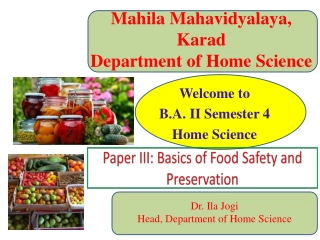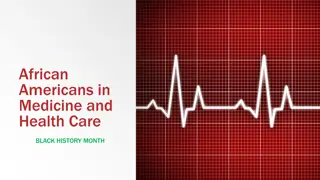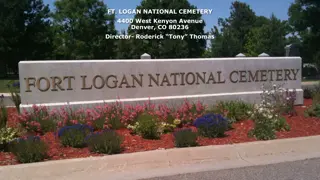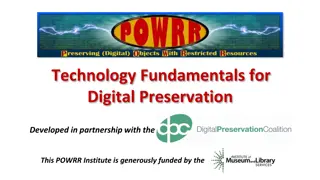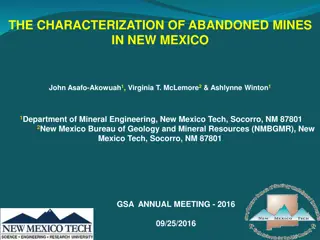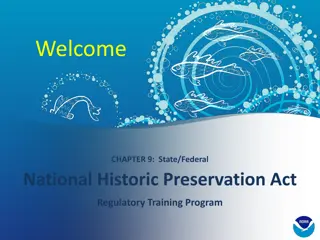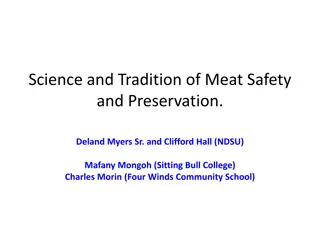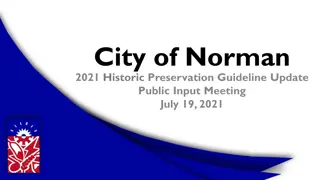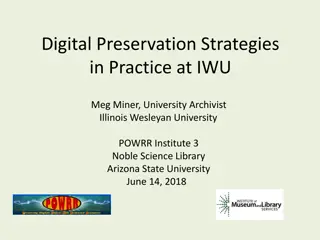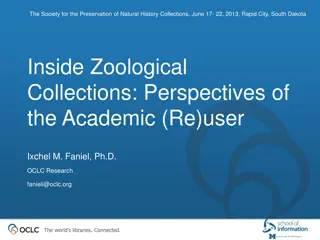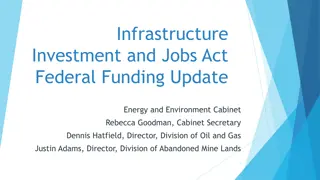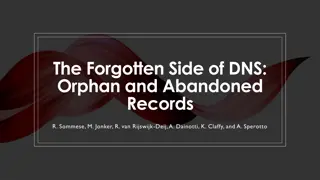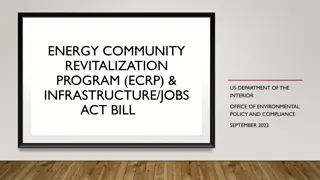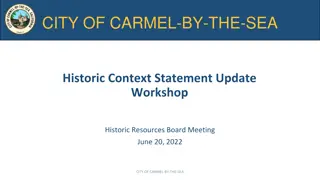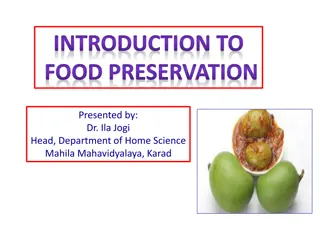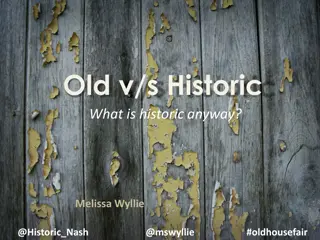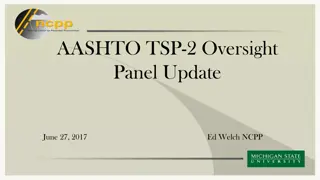Historic Preservation Grants: Abandoned African-American Cemeteries
Providing grants for research institutions, nonprofits, and local governments to conduct genealogical research and restore abandoned African-American cemeteries in Florida. Guidelines, application requirements, and submission period details included.
Download Presentation

Please find below an Image/Link to download the presentation.
The content on the website is provided AS IS for your information and personal use only. It may not be sold, licensed, or shared on other websites without obtaining consent from the author. Download presentation by click this link. If you encounter any issues during the download, it is possible that the publisher has removed the file from their server.
E N D
Presentation Transcript
Abandoned African-American Cemeteries Grants HISTORIC PRESERVATION GRANTS PROGRAM
Program Overview Historic Cemeteries Program - HB 49 (ch. 2023-142, Laws of Florida) Duties and responsibilities include, subject to legislative appropriation, providing grants to the following entities: Research institutions, colleges and universities, and qualified nonprofit organizations for the purpose of conducting genealogical and historical research necessary to identify and contact the relatives and descendants of persons buried in abandoned African-American cemeteries. Local governments and qualified nonprofit organizations for the purposes of repairing, restoring, and maintaining abandoned African-American cemeteries. Section 6 of HB 49 appropriated $1,000,000 in nonrecurring grant funds from the General Revenue Fund for grant funding in the 2023-2024 fiscal year.
Grant Program Governance Section 267.0617, Florida Statutes, Historic Preservation Grant Program Section 267.21, Florida Statutes, Historic Cemeteries Program Chapter 1A-39.001, Florida Administrative Code Abandoned African-American Cemeteries Grant Guidelines The Guidelines can be found on the DHR Grants Program webpage. https://dos.fl.gov/historical/grants/abandoned-african-american-cemeteries-grants/ The Guidelines contain information that pertains to the entire grant process from application through funding and management. Prior to submitting an application, potential applicants should review these Guidelines, specifically noting sections regarding eligibility, project descriptions, and allowable expenses.
Application Requirements
Application Submission Period Submission Period Opens: Submission Period Closes: November 1, 2023 November 30 (5:00 p.m. Eastern) Applications are submitted via the DOS Grants System at DOSgrants.com. Applications will be evaluated on a competitive basis and the selected projects will be awarded funds for FY2024 (July 1, 2023 June 30, 2024).
Cemetery Eligibility The Cemetery must meet the following requirements: It shall not be a licensed cemetery under Chapter 497, Florida Statutes. It shall have a majority of interments occurring more than 50 years ago, with no recorded interment in the previous 10 years and no contracted future interments or other burial rights. Its presence shall have been previously reported, recorded, identified, or documented through archival research, archaeological survey, accidental or intentional ground disturbance, oral history, FMSF Form, etc. It shall have a documented association with interments of persons of primarily African-American ancestry.
Applicant Eligibility Section 267.21(2), F.S., specifies grant eligibility for the following types of applicants and projects: Genealogical and historical research necessary to identify and contact relatives and descendants of persons buried in abandoned African-American cemeteries: Research Institutions Colleges and universities Qualified nonprofit organizations Repairing, restoring, and maintaining abandoned African-American cemeteries: Local governments Qualified nonprofit organizations For further details, see Section II of the Guidelines.
Application Restrictions Applicants may submit only one (1) grant application per application cycle with the following exceptions: County or City governments, or universities may submit single applications from more than one division or department provided those divisions or departments are separate and distinct budgetary units and provided that applications do not address the same Cemetery. Applicants with projects funded with Federal funding or by the Legislature outside of the review of the grant review panel or Secretary of State are not eligible to receive Abandoned African-American Cemeteries grant support for the same Scope of Work from the Division within the same fiscal year. No organization may receive more than $1.5 million in Abandoned African- American Cemeteries grant funding during a consecutive 5 state fiscal year period.
Project Types Cemetery Research awarded to research institutions, colleges and universities, and qualified nonprofit organizations for the purpose of conducting genealogical and historical research necessary to identify and contact relatives and descendants. Note, research projects do not fund archaeological fieldwork or comprehensive field surveys of geographic areas whose goal is to locate and identify abandoned cemeteries.
Project Types Cemetery Protection awarded to local governments and qualified nonprofit organizations for the purposes of repairing, restoring, and maintaining abandoned African-American cemeteries. This includes: Planning to guide long-term preservation (e.g., existing conditions assessments, architectural/engineering drawings, and management plans). The restoration of historic funerary resources and the in-kind replacement of resources that cannot be repaired. Removal of vegetation that negatively impacts the historic resources. Installation of appropriate security features, including lighting or fencing. Installation of limited interpretative signage. Marking of unmarked remains, which is approved by the Division and consistent with SOI Standards. Note, this does not include archaeological fieldwork, other than remote sensing techniques such as ground penetrating radar and magnetometry performed by a professional archaeologist to determine the boundaries of the cemetery or location of interments for planning purposes.
Award Amount Applicants may request up to $50,000. The is no minimum request amount There is no match requirement for this program.
Application Review
Staff Review The technical review of applications verifies: The Cemetery is eligible The Applicant is eligible Proposed project is consistent with selected project type Non-allowable expenses are not included in the Scope of Work or Budget All supporting documentation has been provided Only documents that are provided in response to requests for clarification from staff will be considered after the application deadline.
Panel Review Eligible applications will be reviewed by an appointed grant panel at a public meeting. Panel members independently evaluate each application in DOSGrants.com based on the review criteria in the program Guidelines. After members have evaluated the applications, there will be a public meeting to review, discuss, and score the applications. Members scores will be averaged by DOSgrants.com to determine the final score of each application.
Criteria and Scoring Eligible applications will be reviewed based on 8 scored criteria. Points for each criterion vary, with total possible score of 100. Applications must receive a minimum average score of 80 or higher to be recommended for funding. Evaluation will be based on the information contained in the application and support materials. For further details, see Section VII of the Guidelines.
Criteria 1. Criteria Related to the Site or the Proposed Project: a. Historic and cultural significance, meaning the relative importance of the Cemetery in connection with historical events, developments, or personalities and its present value to the community (up to 10 points). b. Need for the proposed project or activity, including existing or potential threats of loss or damage to the Cemetery or to the genealogical and historic information associated with it (up to 20 points). c. Appropriateness of the proposed project scope of work, budget, and timeline in relation to the property, site, resources, collections, or information that form the basis of the proposed project (up to 10 points).
Criteria 2. Criteria Related to Organization Administration: a. Administrative capability, as demonstrated in the application, including staffing, facilities, and organization resources adequate to complete the proposed project and meet the administrative requirements of the grant. Applicant administrative experience with previous or open grants awarded by the Division, other divisions of the Department of State, and other granting entities (up to 10 points). b. Financial resources adequate to carry the project costs, as necessary, pending receipt of disbursements of grant funds or to cover project costs exceeding grant funds awarded. Ability of the applicant or property owner to maintain the Cemetery once the project is complete (up to 10 points). c. Consideration for and availability of professional services required to carry out the proposed project, either within the applicant organization or as consultants/vendors (up to 10 points).
Criteria 3. Criteria Related to Public Benefit: a. Public good, including how accessible to the public the Cemetery or information is (or will be when project work is complete), educational potential, or other public benefit resulting from the proposed project (up to 10 points). b. Community support for the proposed project, including from volunteers, partner organizations, descendants, property owners, and other stakeholders (up to 20 points).
Funding Process Following the public meeting, the Division will prepare a final ranked list of all recommended applications for review and approval by the Secretary of State Grant funding recommendations approved by the Secretary of State will be funded top-down on the final ranking list until the appropriation is depleted. Funds will be released to grantees only after a Grant Award Agreement is fully-executed and certain deliverables are met.
Getting Started in DOSgrants.com
DOSgrants.com Must complete an online application form at http://www.dosgrants.com by the application deadline (November 30, 5:00 p.m. Eastern) Applicants must have a DOSgrants.com account For more information on creating an account, click here.
Organization Association Applicants must be associated with an organization to apply for grants For more information, click here.
Organization Association If a profile for your organization does not exist, you must create one For more information, click here.
Organization Profile Applicants should verify that the following information is included in the Organization profile: Phone number (with extension if applicable) Principal Address Mailing Address Website Org Type County Fiscal Year End Date
Organization Roles Organization Manager Permissions: May view, edit, and submit applications; May edit profile and add/edit staff Profile Editor Permissions: May edit Organization Profile Grant Editor Permissions: May edit applications but may not submit Submitter Permissions: May view and submit applications Viewer Permissions: May only view application details
Finding and Completing the Application
Project Team Proposed Project Team Those who will be directly involved with the execution of the grant project The curricula vitae/resumes of the proposed project team are to be uploaded in the Support Materials section of the application Corresponding criteria: Administrative capability Professional services
Grant Experience Corresponding criteria: Administrative capability
Project Information Select the project type for which grant funds are requested Read project descriptions carefully Applicants whose scope of work does not agree with the selected project type will be declared ineligible If you are unsure which project type to pick, contact us and we will be happy to assist you. Enter the project title and location The title entered here is what will remain with the project
Cemetery Information Applicants must list the name of the property owner where the cemetery is located and choose the appropriate owner type. For projects that require physical access to the Cemetery, if the applicant is not the legal owner of the property, the applicant must secure Property Owner concurrence or have the right to maintain the cemetery pursuant to Section 704.08, Florida Statutes, which shall be documented by a court order. The Owner Concurrence documentation shall be uploaded in the Support Materials section of the application
Cemetery Information Provide details about the Cemetery that is the subject of the grant project Is it licensed under Chapter 497, F.S.? Did the majority of burials occur at least 50 years ago? Was the last burial more than 10 years ago? Dates of earliest and latest burials Number of burials What is the physical context of the Cemetery? Questions to consider: What is the existing condition? In a rural or urban environment? On private or publicly owned land? Size, number of known burials?
Cemetery Information Local Protection Indicate the level(s) of local protection afforded the cemetery or the property where it is located: Local Ordinance Design Review Preservation or Conservation Easement Protective/Restrictive Covenant Maintenance Agreement/Long Term Lease Other None A copy of the local protection documents must be uploaded in the Support Materials section Corresponding criteria: Need Historical and cultural significance
Section D: Historical & Cultural Significance
Historical Significance Indicate the type of historical designation the resource has received, if any Provide historical designation details, including the name of the property and date designated Provide a summary/narrative of the historical and cultural significance of the cemetery. For example: Available information on the cemetery s burials and cultural context Are there any distinctive features? Are any historical figures/events associated with the resource? Describe the Cemetery s relationship with the history of African-Americans in Florida and its present value to the African-American community Corresponding criteria: Historical and cultural significance
Professional Services Will you be hiring professional services (historical/genealogical research, architectural/engineering, archaeological, or historic preservation consultant services) with grant funds for this project? If so, make sure to include those services in your scope of work and budget If no, will the professional services of existing staff be used instead of contracting those services? If no services are to be hired and no staff services will be utilized for this purpose, will professional services be paid for outside of the grant project (i.e., with funds other than grant funds)? If no professionals are projected to be hired, explain why. Note, that all grantees are required to use the services of qualified professionals
Scope of Work Briefly describe the scope of work for the project for which funding is requested This is a task-orientated question What product or goal is your organization wanting to complete? What steps do you need to take to accomplish the goals? What professional or technical services will be used? Corresponding criteria: Appropriateness Professional Services
Scope of Work Content (example tasks) Cemetery Research Ex) conduct genealogical and historical research (Where? How? Resources? Methodology?) Ex) conduct oral histories Ex) prepare final product (report, website, etc.) Cemetery Protection Ex) repairing, restoring, and maintaining the cemetery Ex) develop architectural/engineering/construction documents Ex) develop a conditions assessment Ex) remove harmful vegetation Ex) install security features
Timeline Use this section to demonstrate that the project can be completed within the grant period Major project elements to consider: GAA execution Procurement Completion of each scope of work item Corresponding criteria: Appropriateness
Cemetery Research Describe current state of the research regarding the Cemetery Indicate how the research will be conducted and the methods that will be used Will this project produce any publicly available materials about the research? Corresponding criteria: Appropriateness Professional Services Public Benefit
Cemetery Protection Provide measurable quantities for each work item listed in the Scope of Work Ex) number of headstones/funerary objects to be restored Ex) linear feet of security fencing Corresponding criteria: Appropriateness Professional services
Need Discuss the need for the proposed project or activity: Any existing or potential threats of loss or damage to the Cemetery or to the genealogical/historical information associated with it. Upload relevant documentation, such as: Newspaper articles Deeds Cemetery registers Corresponding criteria: Need
Care and Maintenance Describe any plans for long-term care and maintenance of the Cemetery beyond the grant period. Corresponding criteria: Need Appropriateness Financial Resources

 undefined
undefined








